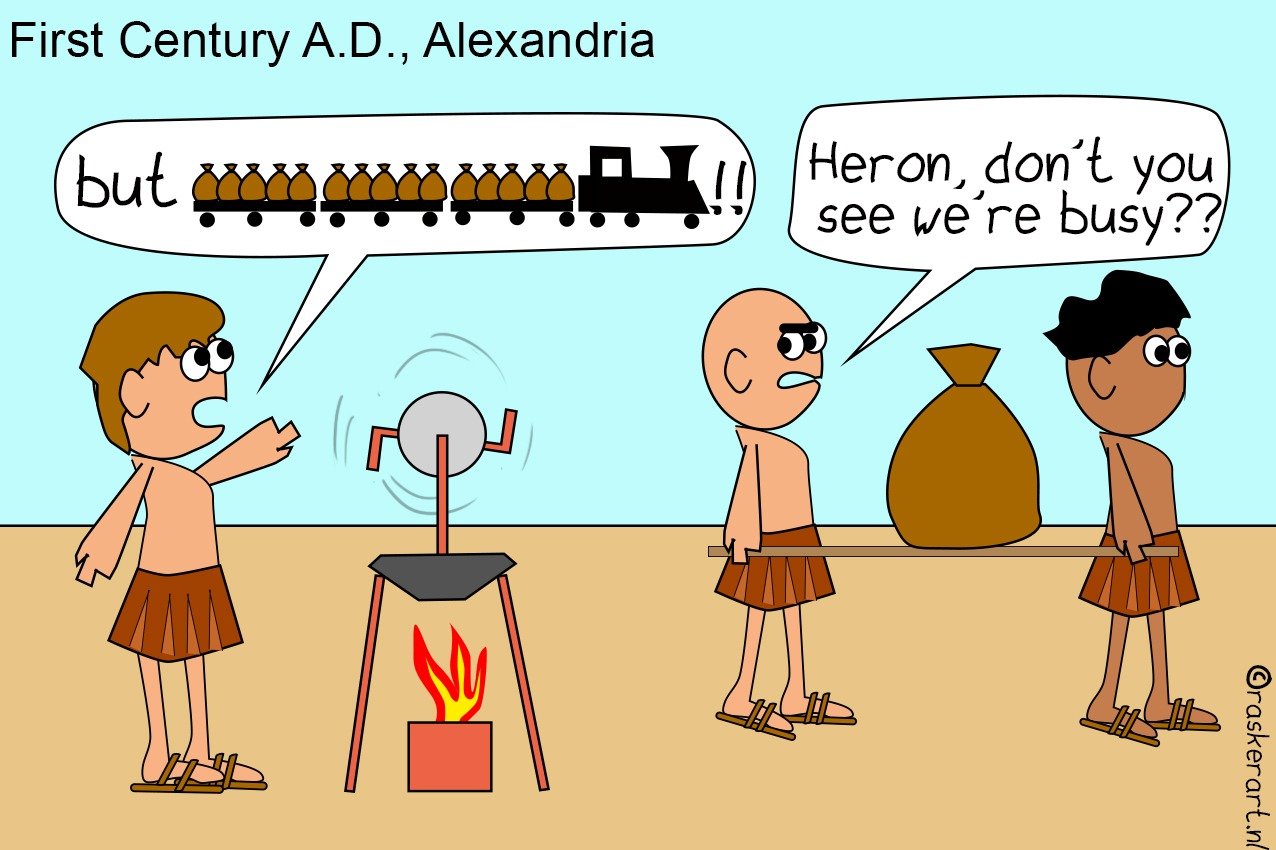
Because of an article I wrote last year about the importance of open innovation, I got to give a presentation for Digital Wednesday last week. Now, I’m not the expert or researcher who has analyzed all the theories around this concept, but thanks to the thousands of practical examples we’ve seen over the years at Innovation Origins, I do have a pretty good idea of what works and what doesn’t. It’s no coincidence that we use three examples in our PR video of innovations that could have led to faster results with a bit more openness. The pyramids, the printing press, the automobile: the ideas for these innovations always originated in different places and at different moments in time – with a bit more coordination and active knowledge sharing, they would certainly have led to more impact or faster results.
This is even more true of the Aeolipile (“wind ball”), an invention that was the common thread in my presentation last Wednesday. For those not already familiar with it, it’s almost too bizarre to be true. The Greek Heron, who lived in Roman-controlled Alexandria, made a prototype of this device in the first century AD. For anyone looking at it now, it is clear at once that this is nothing less than a primitive version of the steam engine. Indeed, the same invention that turned out to be one of the main drivers of the industrial revolution in the eighteenth century.
Steam engine
It’s mindboggling to see how small the step is from the Aeolipile to the steam engine. And yet it took another millennium and a half to get there. What was the reason for that? Scholars disagree on that, but what is clear is that no one at the time saw any practical use for Heron’s wind ball. Yes, it could be used to demonstrate certain natural laws, but that was about it. But that would undoubtedly have been different if Heron had put more effort into sharing his invention (which, by the way, was in itself inspired by even earlier designs).
Because that’s really how it always goes, is our experience based on 18,000 innovation-related articles on Innovation Origins. Those who share not only go faster but also get further. Of course, there are also examples where this is not true, as a few people in our audience showed last Wednesday. But that doesn’t make Heron’s lesson any less powerful: those who don’t share stand still, sometimes for more than 1,500 years. And so you can expect us to continue to show you all those beautiful innovations that come from all corners of Europe (and Alexandria 😁). So you can be inspired by them and, preferably, build further on them. We had quite a few examples of that last week as well. These stood out to me the most:
Last week’s highlights
Construction is a sector that seems to be struggling to become more sustainable. Zeeshan Ahmed is determined to change that with his start-up Zavhy, he told colleague Aafke Eppinga last week. He wants to automate, digitize and make the sector more sustainable with 3D concrete printing. More here.
Also from Aafke is the interview she had with Kasper Valgepea for our series Decarbonizing Europe. This scientist runs a laboratory in Estonia where CO2 is seen as a valuable raw material for new products, rather than a polluting gas. It’s yet another example of smart thinking around CO2 – I’m sure we’ll start seeing widely deployable applications of it in the near future. More here.
At least as interesting is the way in which the Limburg-based company Lake3D is using innovative printing technology to produce high-quality teeth and dental prostheses (and in the right color). In the article by Emile Hollman, Jessica Pepe and Kim Alards talk about the advantages, technology, and requirements that our teeth of the future will have to meet. More here.
Swiss students from the team SOWA also managed to turn their idea of using solar-powered electrodialysis for a mobile water purification device into a working model, according to colleague Polya Pencheva. More here.
Finally, the acute power problem in the provinces of North Brabant and Limburg also kept us busy, of course. And as you’ve come to expect from us, we didn’t limit ourselves to pointing out the problem. Here is a short overview of the alternatives that are available now that congestion is plaguing the power grid.
On behalf of all our colleagues across Europe, I wish you a beautiful Sunday – and please keep thinking of Heron if you have a good idea. Because, as Open Innovation guru Henry Chesbrough says: “Not all smart people work for you”.








